Fixed interest watchlist for fixed interest investors in 2014
In the first of his regular commentaries this year Harbour Asset Management director of fixed interest, Christian Hawkesby, spells out the eight key indicators to watch over the next 12 months.
Monday, January 20th 2014, 10:26AM
by Harbour Asset Management
Continuation of a theme in December...
NZ and global interest rates continued to drift higher in December, continuing the theme of 2013. The NZ 2 year interest rate swap ended the year at a high of around 3.85%, up around 15 basis points on the month. The US 10 year government yield ended the year at around 3.0%, the highest point in the year.
The main event in December was the NZ Treasury’s half yearly fiscal and economic update. An improved fiscal outlook resulted in a reduction in the NZ government bond issuance program by $4bn. Combined with the usual suspension of government bond tenders over the Christmas/New Year period, this created a scarcity bid for NZ government bonds in December.
Fixed interest returns in 2013…
It was an eventful year for fixed interest investors in 2013. Global yields rose notably as the US Federal Reserve hinted at the prospect of tapering QE purchases. Local fixed interest yields rose even further, as the economy gained momentum and the market began to price-in upcoming Official Cash Rate (OCR) hikes from the RBNZ. With the economic outlook improving and policy stimulus continuing, corporate bonds outperformed government bonds.
|
End 2012 |
End 2013 Yield (%) |
Change in Yield (%) |
Annual Return(%) |
|
| NZ fixed interest | ||||
| 90 day bank bills | 2.68 | 2.84 | +0.19 | +2.67 |
| 2 year interest rate swaps | 2.67 | 3.84 | +1.17 | +1.56 |
| NZ ANZ Corporate A Grade Index | 3.85 | 4.58 | +0.73 | +1.89 |
| NZ ANZ Corporate Stock Index | 3.02 | 4.13 | +1.11 | -1.97 |
| Global fixed interest | ||||
| Barclays Global Aggregate | 1.70 | 2.11 | +0.41 | +2.17 (NZD hedged) |
Source: Bloomberg, ANZ and Barclays.
A watchlist for fixed interest investors in 2014
In our opinion, there are 8 key things to watch in 2014.
1. US unemployment and inflation: Long-term global bond yields rose notably in mid 2013 as the US Federal Reserve (the Fed) hinted at scaling back monetary stimulus. Watch for signs that the US unemployment rate and US inflation rate are gradually coming back to their targets of 6.5% and 2% respectively, or whether the Fed needs to significantly change its course. While unemployment is approaching target, inflation remains significantly below.
US unemployment and inflation
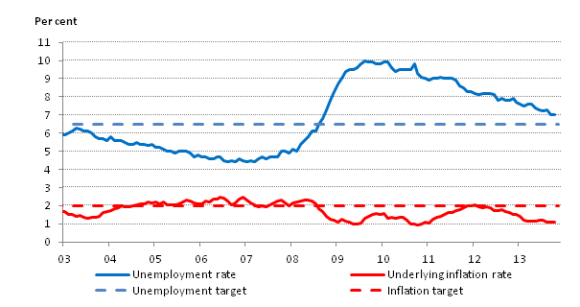
Source: Bloomberg.
2. NZ macroeconomic momentum: New Zealand has a standout economy on the global stage. In our opinion, the key question is not if the RBNZ increases the OCR in 2014, but when the RBNZ will start hiking the OCR, and how far the OCR will eventually rise. The market is pricing 125 basis points of OCR hikes from the RBNZ in 2014 – about as much as the most upbeat economist. This will require the NZ economy to deliver on the momentum and promise we have seen in business and consumer confidence surveys. Watch for news on the housing market, credit growth, export prices and agricultural conditions.
NZ business and consumer confidence
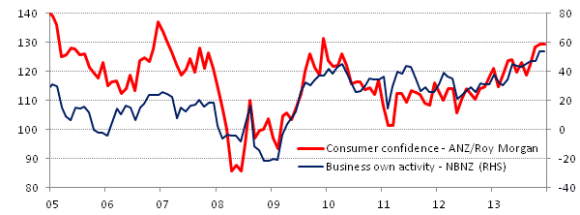
Source: Bloomberg.
3. NZ dollar: An overvalued NZ dollar has been a continual headache for the RBNZ in recent years, but another key theme has been the lack of volatility in foreign exchange markets more generally. Watch for a potential re-emergence of exchange rate volatility, which could either accelerate or hamper the RBNZ’s plans to be the only central bank hiking substantially in 2014.
NZ and US trade weighted indices (TWIs)
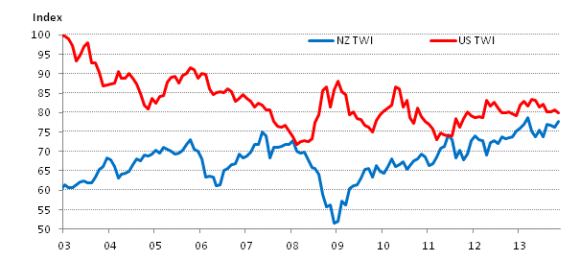
Source: Bloomberg.
4. Sensitivity to interest rate rises: Ever since the OCR was cut to record lows following the GFC, mortgage holders have migrated to floating interest rates or fixed rates with less than 1 year to maturity. This makes household cashflows much more sensitive to the OCR, compared with pre-GFC when over 50% of mortgages were fixed for more than 1 year. Watch for signs of whether the household sector can withstand incremental moves higher in the OCR in 2014.
Residential mortgage loans outstanding
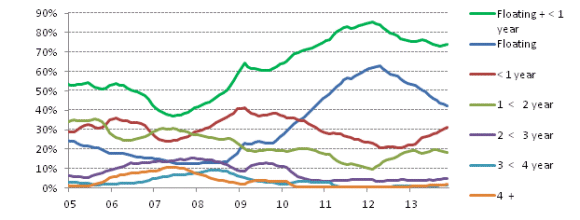
Source: Reserve Bank of New Zealand.
5. NZ inflation expectations: NZ inflation was below the RBNZ’s target range for much of 2013, held down by an elevated exchange rate and subdued global inflation. Demand for NZ inflation-linked securities could pick up as they enter global bond indices at the beginning of 2014. Watch for evidence of re-emerging NZ inflation pressures and wage demands, which could fuel a wider appeal in inflation-linked securities.
NZ inflation expectations 2 years ahead – RBNZ survey
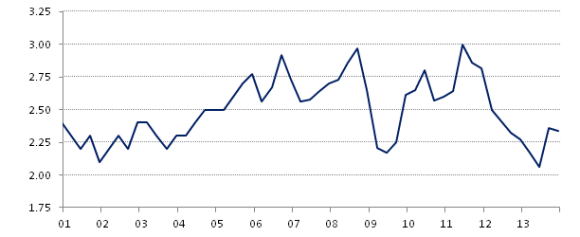
Source: Reserve Bank of New Zealand.
6. NZ general election: For fixed interest investors, watch for any changes in the RBNZ’s mandate that could muddy its policy focus, dent its credibility or erode its independence. Also watch for any loosening in the fiscal reins, which could send interest rates and the exchange rate higher than otherwise. For corporate bond investors, the election could have some impact on the regulated companies in the electricity sector, although less so than equity investors.
Herald digipoll (December 2013), projected seats in Parliament
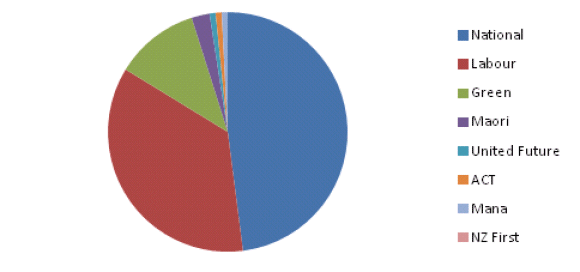
Source: Herald.
7. Corporate credit spreads: Corporate bonds outperformed government securities in 2013, supported by an improving economic outlook and continued policy stimulus. Corporate bond issuance began to pick up in the second half of the year, as narrowing credit margins attracted corporate borrowers to cheaper funding. As retail issuance looks to pick up in 2014, watch out for any new deals where credit margins have narrowed so much that they provide investors with insufficient compensation for the risks.
NZ Credit Spreads (over swap rates)
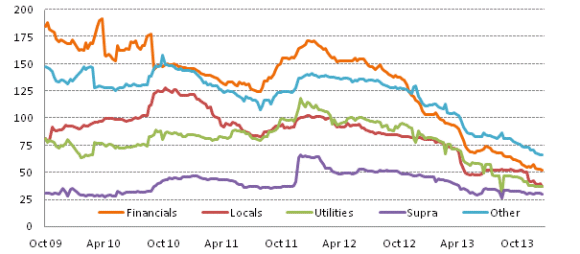
Source: Harbour Asset Management.
8. Tail risks: The European sovereign crisis and US debt ceiling debates have dominated headlines since 2011, given their ability to trigger widespread flight to safety and a closure in global funding markets. The French economy appears to be a potential catalyst for renewed European challenges. The growth of Chinese local government debt is also in the spotlight. The woes of Solid Energy and its bondholders in 2013 was a reminder that corporate bond investors also need to also continually watch for company-specific risks.
European Purchasing Manager Indices (PMIs)
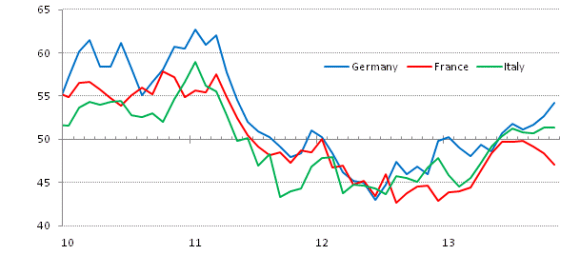
Source: Bloomberg.
Conclusion
In our opinion, the key question for NZ fixed interest investors is not if the RBNZ increases the OCR in 2014, but when the RBNZ will start hiking the OCR, and how far the OCR will eventually rise.
With market yields starting 2014 at a considerably higher level than 2013, the market is pricing-in around 125 basis points of OCR hikes, which is about as much as the most upbeat economist.
New Zealand bond yields look more appealing now than at the beginning of 2013. However, economic momentum also appears stronger than the start of 2013, pointing to scope for market yields to rise even further.
Following the first hike in the RBNZ’s Official Cash Rate (OCR), the onus may come back on economic data to confirm that the economy can withstand incremental moves higher in the OCR. Keep watching the key drivers of NZ fixed interest in 2014.
Christian Hawkesby,
Director, Fixed Interest,
Harbour Asset Management
Important disclaimer information
| « The 2014 ETF giveaway – 6 chances to win… | Fair play for investors - improving fund disclosure » |
Special Offers
Comments from our readers
No comments yet
Sign In to add your comment
| Printable version | Email to a friend |









